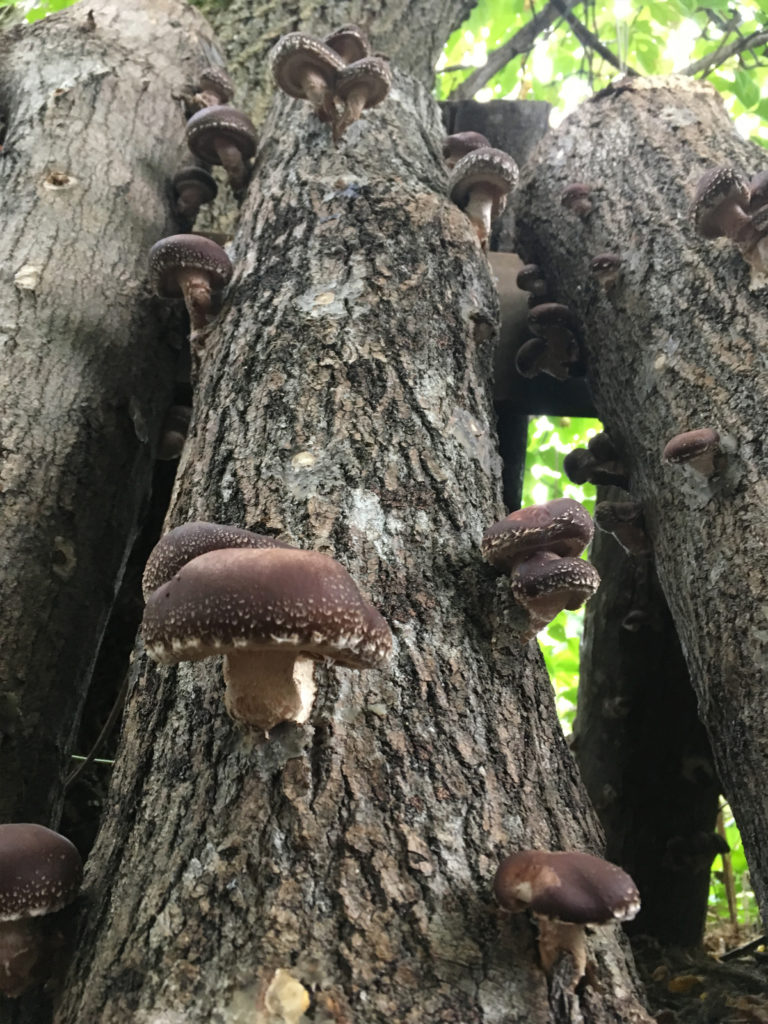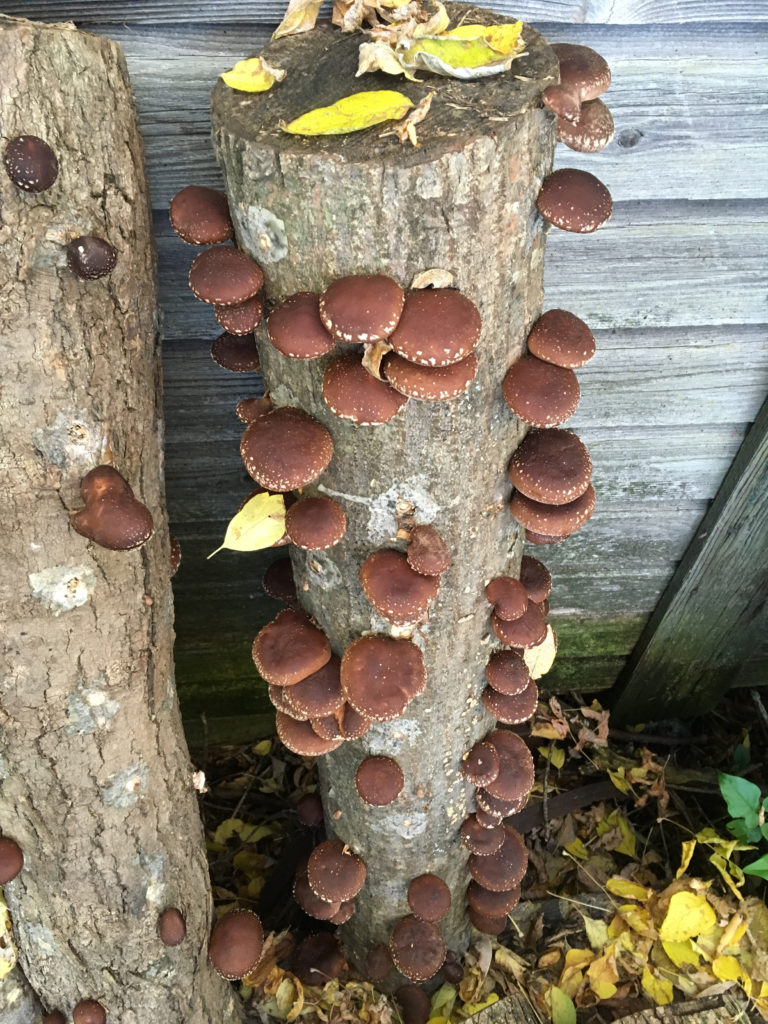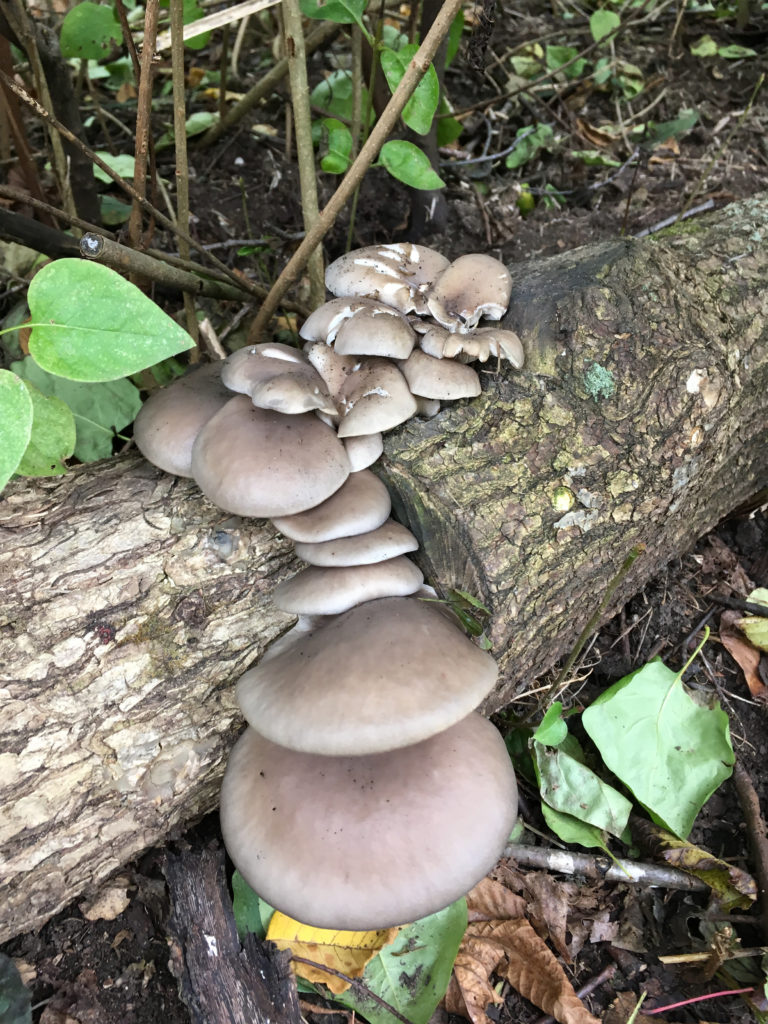

Log Cultivation Overview
A wide variety of edible mushroom species can be grown outdoors on hardwood logs. Fungus is introduced via plug or sawdust spawn and in a period that ranges from 6 to 12+ months, the fungus fully colonizes the logs. A similar process would occur naturally on a fallen tree, but this would normally take much longer and could involve several species of fungi, all in competition to colonize the log. Oyster mushroom logs will produce a significant yield of mushrooms as early as 12 months from inoculation, whereas Shiitake can take closer to 18 months. A medium sized log could fruit for 5+ years if properly cared for. The pre-plugged logs for sale from Forest Floor are at least 12 months old and are sold fully colonized. Mushroom log cultivation is one of the most simple and accessible methods for beginner growers and one can achieve a perennial mushroom harvest with very minimal work.

Oyster Log Care Instructions
Oyster mushroom logs are the perfect addition to any garden. The main requirement is a fully shaded area, or an area that receives only dappled sunlight. There are several ways the logs can be positioned. The logs can be partially buried lengthwise, leaving about 2/3rds of the log above ground. Partially burying the logs will help them retain moisture and prevent the bark from detaching (which can be common with some softer hardwoods picked specifically for Oyster cultivation). Multiple logs in this position can be used to edge a garden. Alternatively, the logs can be buried upright, in a post position with about a third beneath the surface. The logs can also simply be placed directly on the ground, or propped up on an object. Positioning and stacking is dependant on the number of logs you have. One or two can be placed basically anywhere, however if you have several logs there are benefits in stacking them all together.
Once the logs are installed in their permanent location you get to play the waiting game. In times of drought it would be a good idea to give them a soak with a garden hose, but otherwise they should stay perfectly hydrated all on their own with regular rainfall. If propped up the logs should be flipped end over end once every few weeks. Its always a good idea to keep an eye on the logs and check for healthy white mycelium. The ends of the logs will have white patches and mycelium can also be visible around the inoculation points. If buried, when you dig down a bit in the soil around the logs, you should be able to see white strands of mycelium expanding outward. To ensure adequate moisture content it is a good idea to soak your logs at the beginning and end of each season (this does not apply to buried logs). Refer to Shiitake Instructions for more on this. The most common variety of Oyster, Pleurotus ostreatus, is a cool weather mushroom. They will most likely fruit in late summer/fall or spring. When some mushrooms do appear, keep an eye on them, as squirrels and slugs can make short work of your crop.

Shitake Log Care Instructions
Shiitake logs also work well in most backyards, provided they are in a shady or dappled area, and are sheltered from any prevailing winds. The biggest worry in log cultivation is the logs drying out, which will kill the fungus. If the logs are in a good spot, this isn’t as much of a concern, however as with the Oyster logs it is a good idea to give them a good splash with a hose from time to time. To begin every year after the thaw, the logs should be soaked for 24 hours. This ensures the logs are well hydrated going into the spring. The logs should also be soaked at the end of the season after all fruits have been harvested. A rain barrel, kiddie pool, or natural pond or stream can be used to hydrate the logs. There is also the practice of force fruiting in Shiitake cultivation, which involves periodically soaking the logs in order to trigger fruiting. Unlike Oyster logs, Shiitake logs should not be buried or laid directly on the ground. Shiitake logs prefer to be upright, leaning against tree, fence, building or any object that is going to keep the log off the ground. This will allow mushrooms to grow out around the entire surface of the log. If you have 5+ logs you could consider crib or low rail stacking methods. See the links below for pictures of stacking methods. Shiitake are also cool weather mushrooms so expect mushrooms in late spring, late summer or fall.
Important I.D. Information
When I inoculate my logs, I can say with 100% certainty that the fungus I am introducing, is an edible variety of Oyster (Pleurotus ostreatus), Shiitake (Lentinula edodes) or other some mushroom species, however, there is always a chance with log cultivation that competitive fungi, which may have pre-existed on the logs, can grow in combination with the introduced species. For example, this past year some of my Shiitake logs began producing Bulgaria inquinans, a jelly like sac fungi, and I also found some Schizophyllum commune (Common Split Gill) on my Oyster logs. I was neither surprised nor upset about finding these on my logs, it is simply something to be aware of. The introduced fungus will almost always outcompete other species in the long term, but competitors will always put up a fight. It is a good idea to familiarize yourself with the characteristics of the edible species you are growing, and be able to differentiate from other species. Usually this is simple, as competitive species rarely closely resemble their edible counterparts.
If you have any further questions regarding your log, feel free to email me at brodie@forestfloormushrooms.com or send a message to me via @forestfloormushrooms on Facebook. The following links are excellent resources, providing detailed cultivation information and instruction as well as photos of stacking methods.
If you have any further questions regarding your log, feel free to email me at brodie@forestfloormushrooms.com or send a message to me via @forestfloormushrooms on Facebook. The following links are excellent resources, providing detailed cultivation information and instruction as well as photos of stacking methods.
Resources